Motorhome cleaning: all you need to know
Whether you're heading out on your first big trip of the year or your motorhome or campervan simply needs a spruce up, our guide to cleaning a motorhome will show you how to get it looking good as new
Page contents
- Why motorhome cleaning is important
- How often should you clean
- Motorhome cleaning products
- Motorhome awnings
- Cleaning exterior bodywork
- Interior cleaning
- Motorhome waste and water tanks
- On-the-road cleaning
Why motorhome cleaning is important
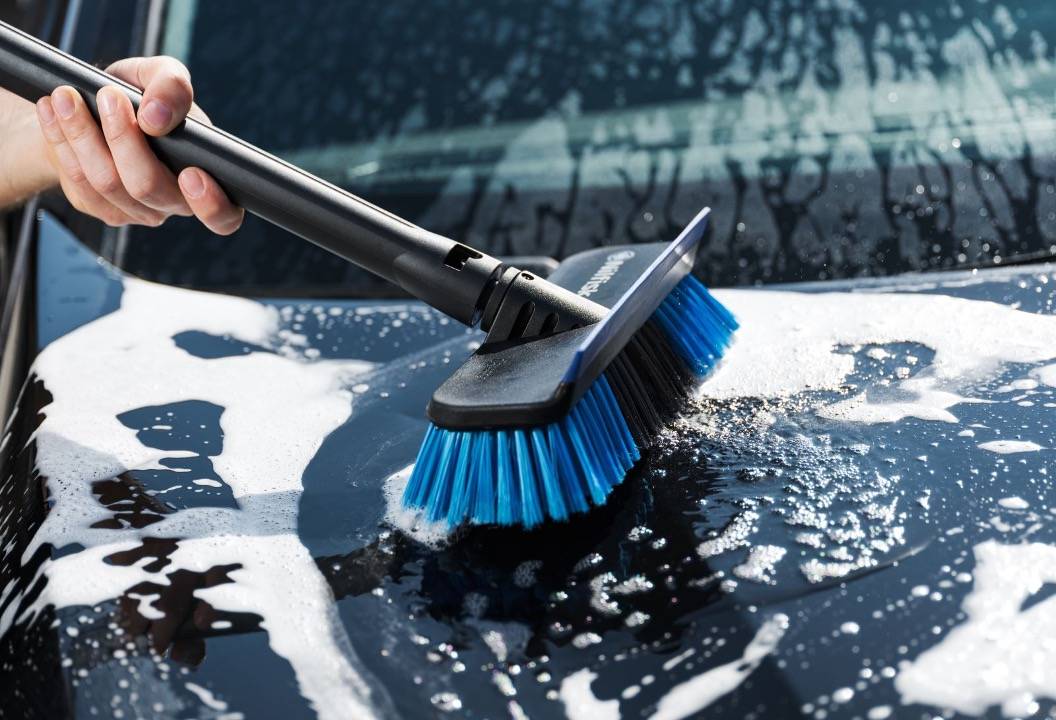
(Photo courtesy of Nilfisk)
Most motorhome and campervan owners will consider changing their unit at some time in the future and uncared-for bodywork and interiors will wipe hundreds of pounds or more off the motorhome’s value. With that in mind, keeping up appearances will enhance the long-term value of your motorhome and give you continuing pleasure of ownership.
But keeping your motorhome or campervan clean isn’t always easy – throughout the year you’re up against acidic rainfall, dust, grit particles and road grime acting on your GRP bodywork or metal panels. Then there are tree resins and bird droppings further adding to the array of factors to degrade your bodywork.
Inside, regular use of your motorhome or campervan with activities concentrated in such a small area is likely to see the interior fabric suffer more than at home - plus, add mucky pets and dirty walking gear into the mix, and our motorhome interiors don't really stand a chance!
Not only will a good clean – inside and out – make you feel better about your camper, but it will help keep it in good shape, and prevent the acceleration of ageing and consequential loss of value.
How often should I clean my motorhome?
The simple answer – as often as you can! Giving a motorhome GRP or campervan exteriors a thorough clean is a big job, but keep on top of grime build-up, and you’ll find each cleaning session becomes a little less tough.
Many cleaning experts recommend giving your leisure vehicle a big clean once or twice a year – perhaps spring and pre-winter are the obvious times to do this – followed by frequent, smaller cleans throughout the year to keep on top of dirt.
What motorhome cleaning products to use
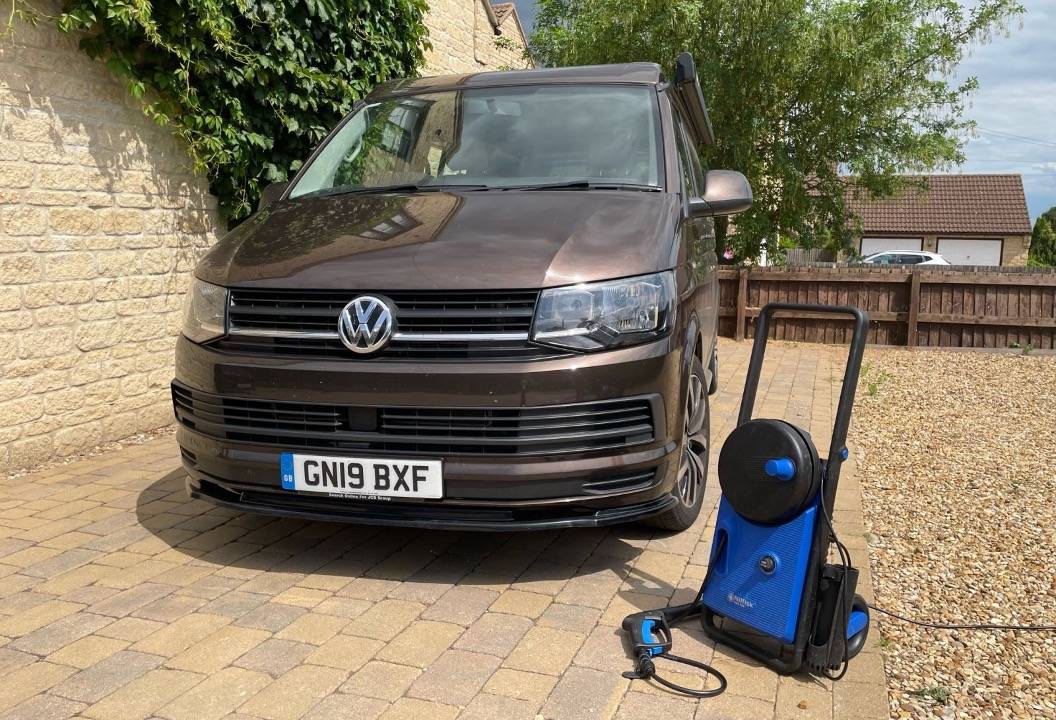
(Photo courtesy of Nilfisk)
Motorhomes and campervans are an expensive investment, and the last thing you want to do is damage the paintwork, GRP bodywork or seals around windows, etc, with unsuitable cleaning products and tools.
It’s always best to use cleaning products specifically formulated for motorhomes (or caravans) as some cleaners can be too harsh for some of the many materials that are used on leisure vehicles. Clearly, buying cleaning products produced by the likes of Thetford and Dometic for cleaning their own products is ideal in that you know they won’t harm the materials used by that manufacturer in their products.
Choose good-quality brushes, sponges and cloths to apply your cleaning products. A brush with a soft wrap-around head on a long extending handle will safely reach the upper parts of your motorhome, but there are a wide range of brushes available made specifically for cleaning motorhomes and campervans. Telescopic brushes are particularly popular as these allow you to reach up high (though you may still need a step ladder).
Alternatively, use a sponge with an open texture or a microfibre wash pad or mitt, but take care when using ladders for the upper levels. The aim is to use products that allow dust and grit to work into the applicator fabric rather than remain on the surface and grind into the paintwork.
On this score, it’s worth considering fitting a grille at the bottom of your wash bucket to allow detritus washed off the bodywork to fall through the grille and avoid it being picked up again by your brush or sponge.
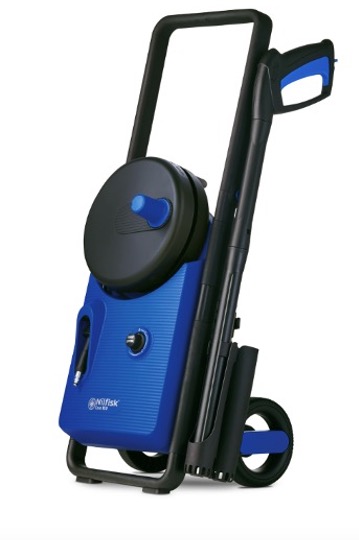
(Photo courtesy of Nilfisk)
As a general rule, it's best to exercise caution when purchasing cleaning products and tools as you want to ensure you don't scratch the bodywork. Having said that, something as simple as a soft toothbrush, as we'll explore later, can be a great item to keep in your kit.
One cleaning aid not often recommended is a portable pressure washer. Though they are easy to use and very effective in shifting dirt, they are usually too powerful for delicate materials, including sealants. If you do use one, you must always use the gentle setting.
However, for harder-to-reach areas, take a look at the Nilfisk Core 150 Power Control Motorhome Roof Pressure Washer Bundle , which is ideal for tackling dirt and grime. The bundle includes a telescopic roof cleaner, multi brush kit, auto brush and water-based Car Combi Cleaner detergent. If you struggle to clean your motorhome’s roof, use the long-reach telescopic roof cleaner, which extends up to 4.2m. And, using the brush means there is no actual high pressure. You can also attach the brush directly to the lance of the pressure washer to easily wash lower areas. Plus, it’s great for cleaning dirty bikes if you’ve been for a particularly muddy ride, too! Browse Nilfisk’s website for information.
It’s worth noting that some manufacturers stipulate what cleaning devices cannot be used as this can affect the warranty, so do check.
How to clean motorhome awnings
If you’re wanting to clean your awning, choose a good sunny day and use a product designed for the task such as Fabsil Awning Cleaner – this not only cleans but revives the water repellency.
You simply spray it on and work in with a brush or sponge before rinsing in clean water.
Washing down your motorhome’s exterior bodywork
Before washing, always hose down the body to rinse off surface dust and grit, and this will also soak more stubborn deposits, which will come off more easily when softened with water. If it’s the first wash of the season it’s worth using concentrated formulations, as these are much better at cutting through stubborn dirt, grease and gunge. After the first wash, you can go back to your regular GRP or automotive cleaner.
Apply your cleaning solution by spray, sponge or brush and leave for 30 seconds or so to let deposits soak and soften before agitating the surface with gentle movement. Nilfisk pressure washers offer a foam/detergent sprayer as standard which makes it even easier. Rinse your sponge or brush regularly in your bucket of cleaning solution to release the detritus wiped off the bodywork.
There are two schools of thought about whether to start washing from the bottom and working up or working from top to bottom. The theory about washing from bottom up is that, although dirty water will stream down over the cleaned areas, these areas will remain wet. The top to bottom persuasion works on the basis that water flowing from the top will help soften or swill away heavier deposits of road grime along the lower body.
Whichever way you go, the important thing to obtaining a good finish is that, when you rinse off the washing solution, the surface must still be wet, otherwise some of the dirt you’ve loosened will have dried back on the bodywork.
For the same reason, avoid washing on a hot, breezy day as the dirty washing solution will soon dry on the bodywork before you get to rinse it down, thus leaving dirty streaks behind. Wash relatively small panels at a time where you can rinse before the washed surface dries.
Use an old toothbrush to clean away the build-up of algae around windows and locker doors. Don’t forget your retractable steps – a build-up of grime can clog the mechanism.
For stubborn squashed insects, place a cloth soaked in warm cleaning solution over them for five minutes or so and then try washing off again. If you have any stubborn black streaks or squashed insects on body panels, you can buy specialist black streak remover and insect cleaners.
Some enthusiasts like to apply wax at this stage to provide extra protection and shine, but it’s more work. Sometimes waxes can cause problems over time as they are soft, and stains can become engrained in the wax layer and as solid layers of wax degrade they become dull and grey. View more offers of the Nilfisk range.
How to clean a motorhome roof
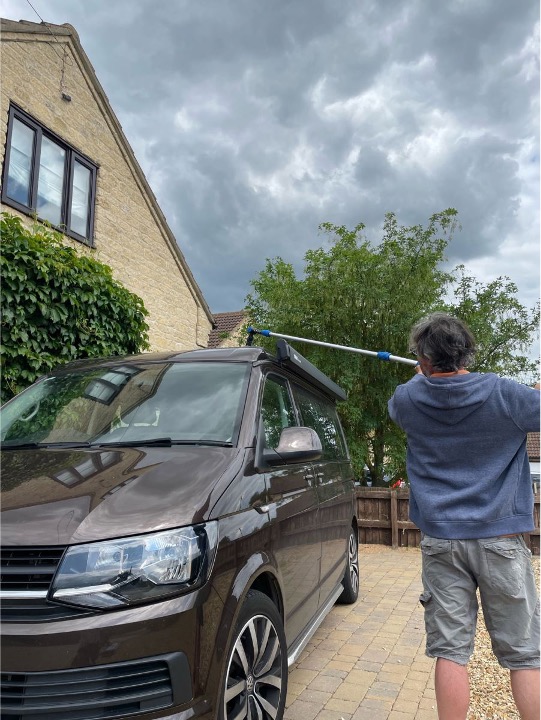
(Photo courtesy of Nilfisk)
Whichever way you wash, always start with the roof as this is where the greatest dirt deposits are likely to be found and they are likely to flow off the roof down the side panels in a random way. Complete the full cycle of wash and rinse on the roof before commencing the walls. Don’t forget the roof-mounted solar panel, a good clean will help it to work efficiently.
If using a ladder, it’s worth enlisting the help of someone else to prevent any ladder-based accidents. Arm yourself with a decent telescopic brush and away you go.
Cleaning acrylic windows on a motorhome
Acrylic windows are excellent at providing lightweight clear glazing but they are sensitive to crazing from exposure to various chemicals and, being a soft material, they are easily scratched.
Because of the danger of scratching the acrylic when cleaning, some advocate wiping the window over with your hand rather than a sponge, or using a specialist acrylic cleaner.
How to clean your motorhome’s wheels
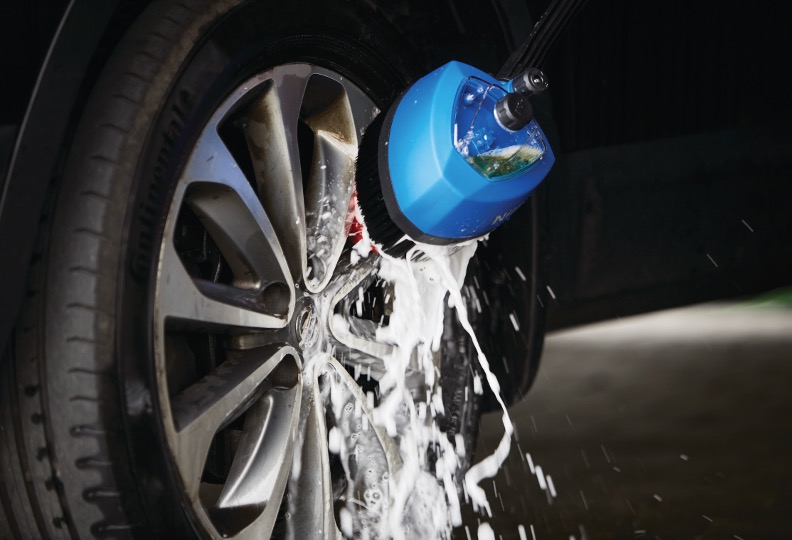
(Photo courtesy of Nilfisk)
Use a specialist brush to make cleaning between the spokes less of a chore. On alloy wheels, it’s best not to use wheel cleaners that contain weak acid, so look for acid-free products. Even weak acid solutions, while they will clean the wheel, may also attack the lacquer coating on the wheel and encourage surface deterioration.
Because of this high-maintenance element of alloys, it’s worth considering applying a product like Simoniz or Autoglym’s Wheel Protector.
Cleaning the interior of a motorhome
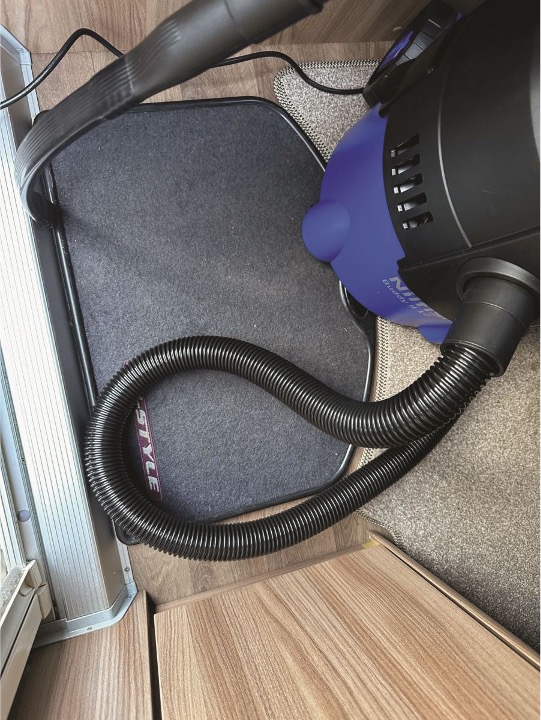
(Photo courtesy of Nilfisk)
Dust and grit accumulating on soft furnishings and carpets will tend to abrade the fabric so a regular vacuum is worthwhile. To remove ingrained dirt and stains you will need a specialist upholstery and carpet cleaner and here you may need to use a non-motorhome specific product, but always refer to the manufacturer’s instructions.
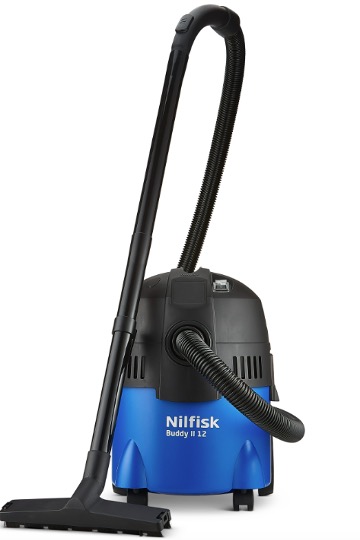
(Photo courtesy of Nilfisk)
One of the simplest things you can do is invest in a multifunctional vacuum with both wet and dry capabilities, and the Nilfisk Buddy II 12 Motorhome Special Vacuum Cleaner is the ideal choice. The powerful 1,200W motor will pick up anything from broken glass (ideal if you’re sharing a motorhome with someone accident prone!) to pet hairs on sofas and dried leaves that gather inside the door and, should there be a drink spillage, it’s easy to clean that up quickly, too.
With its 12-litre capacity, you won’t have to empty it too often, either. Included are the floor nozzle, crevice nozzle and hose storage hooks. Handily, it also has a blow function so can be used to inflate items such as kayaks and air beds.
Cleaning blinds and flyscreens
Start by removing any loose debris from the blinds by using a soft brush, then fill a bucket with warm water and add a small amount of very mild detergent. Dip the cloth into the solution, wring until damp, and, starting at the top, wipe both sides and work your way to the bottom, rinsing the cloth at regular intervals.
Once you've finished cleaning the blinds, wipe them dry with a clean, dry cloth, or leave them to air dry. You can keep on top of the dirt by dusting with a soft cloth regularly.
Cleaning your motorhome kitchen
Clean your refrigerator and freezer interiors with a solution of bicarbonate of soda, using one teaspoon to a litre of warm water. The solution will clean and deodorise the fridge interior without damaging the plastic interior lining. Don’t forget to leave the fridge/freezer doors ajar when not in use to prevent a build-up of mould.
Metal door and locker hinges will benefit from an occasional drop of lubricant to keep them free running and a wipe over will keep them rust free. Be careful not to use solvent-based lubricants which can affect adjacent plastic surfaces so try silicone spray.
A can of silicone spray is also very useful to keep the rubber seals in the toilet cassette and the seals around the external locker supple. However, keep silicone spray away from window seals because of the sensitivity of the acrylic glazing.
How to clean a motorhome washroom
Up to now, cleaning has been largely about the look of the motorhome but, for the washroom, hygiene is also a consideration. Specialist products, such as Thetford Bathroom Cleaner and Dometic Sanitation Cleaner, are available. Thetford’s Bathroom Cleaner is claimed to be safe on all plastics.
A few times a year it’s a good idea to fill the toilet cassette with a lukewarm solution of cleaning fluid and leave overnight. Gently agitate the filled cassette several times as this will help remove any build-up of slime to keep the tank fresh smelling.
To keep your cassette waste tank fresher for longer, use an effective toilet fluid in the cassette waste tank, which will also help break down the waste and make emptying a better experience.
How to clean your motorhome's waste and water tanks
Cleaning and sterilising of the water supply system is essential to avoid contamination of the water, which can lead to gastro-intestinal and other nasty infections if you go on to drink the water. Any build-up of limescale and biofilm over the surface of your tanks and pipes will encourage the growth of bacteria.
So, regularly filling up the system with a suitable cleaning solution and leaving it overnight will provide biocidal cleansing to remove algae and bacteria. Rinse the system through with clean water and you’re ready to go without any fear of residual tainting of the stored water.
Similar products will also clean out your waste tank and pipes to prevent a build-up of slime and subsequent smells. For best results in both situations, use lukewarm water to make up the required solution. Don’t forget to treat your portable filling container and filler hose in the same way. And remember, you must never fill up your tank with a garden hose – always use a food-grade hose to avoid tainting the water.
Truma, which produces many of the water heaters found in motorhomes and campervans, also recommends descaling its hot water boilers twice a year. It’s essential to avoid bleach or any product containing chlorine as this will attack the stainless-steel interior of the hot water tank.
On-the-road motorhome cleaning
Finally, don’t forget as soon as you have cleaned your motorhome that a long journey along the motorway on a rainy day or muddy site access roads can undo some of your cleaning effort. And then there’s the ever-present danger of bird droppings, which can be so harmful to paintwork, especially when it’s sunny weather.
The answer is to carry a spray bottle of your favourite motorhome GRP bodywork cleaning product, plus a microfibre cloth for quick and easy on-site spruce-ups of the exterior.
Expert motorhome advice to your door!
Why not subscribe to one of our fabulous magazines and get expert advice, travel ideas, technical help and all the latest news for your motorhome and your motorhome adventures!

Want to know more about MMM magazine?
Every month MMM has articles written by motorhomers who have been there and done it, from great UK and European (and further afield) tours, campsite reviews, owners' reports and DIY projects among other things.
MMM's tests, reviews and expert buying guides are not to be missed. MMM's technical advice is a must and includes everything from weekend jobs to longer-term DIY projects. And much more!
About MMM magazine
Want to know more about What Motorhome magazine?
Every issue of What Motorhome magazine provides essential buying advice for anyone looking to buy a new motorhome or campervan or upgrade their existing model. With a pedigree of over 30 years of offering the best motorhome and campervan buying advice, every issue of What Motorhome includes more new motorhome and campervan reviews than you will find in any other magazine.
About What Motorhome
Want to know more about Campervan magazine?
Campervan is the exciting monthly magazine that will give you all the inspiration you need to explore the world in your campervan. Every issue is packed with real-life campervanning experiences, inspiring travel ideas in the UK and further afield, the best campsites to stay on, campervan road tests and reviews of the latest models, and much more!
About Campervan magazine








Recent Updates
Engine management lights: all you need to know
What is the engine management light? What does it mean, and what do I have to do? ...
Motorhome air suspension: all you need to know
Motorhomes are heavy and the additional weight of equipment and height of the bodywork can increase the loads ...
Motorhome WiFi: how to get better motorhome internet
Staying connected on the move is more and more essential, so relying on campsite WiFi isn't an option – here ...
A class of their own - our guide to A-class motorhomes
Thinking of trading up to an A-class, or even going straight to the top of the motorhome tree? We guide you ...
Explore overseas on a motorhome dream tour
Enjoy exotic travel in a campervan or motorhome by hiring, swapping with someone else or exporting your ...
Motorhome water systems: everything you need to know
On-board water is an important part of every motorhome – here’s everything you need to know ...
Campervanning in Europe: what you need to know
Whether you're planning a leisurely drive through the French countryside, navigating bustling city streets in ...
Campervan security: all you need to know
With thefts on the increase, it’s important to know how to keep your campervan secure and prevent campervan ...
Campervan furniture: everything you need to know
Our campervan experts guide you through all the essentials for your campervan, including tables, chairs, ...
Campervan finance: how to fund your purchase
Here we look at the different types of campervan finance available, to help you decide what’s the best option ...
Other Articles
Britain’s best used motorhomes
Want a great motorhome without paying the premium for a new one? Here's a guide to the best you can get in the pre-owned market for each layout, ...
Which motorhome? Choosing the perfect motorhome for you
Choosing a motorhome or campervan is one of the biggest buying decisions you’ll ever make, so it's important ...
Campervan washroom essentials: stay fresh on the road
Our guide will take you through the campervan washroom essentials you'll need so you're well-prepared for ...
Dogs in campervans: all you need to know
Follow our advice and your dog will enjoy campervanning as much as you do ...
Electric campervans: all you need to know
Our guide will take you through everything you need to know about electric campervans and what the future ...
Motorhome electrics: a complete guide to your motorhome electrical set-up
Motorhome electrics can dramatically enhance the convenience and comfort of your vehicle – but they can be ...
Lighting for campervans: all you need to know
We guide you through all the lighting options available for you and your campervan, including interior ...
Electric bikes for motorhomes: our ultimate guide
Read our comprehensive guide to electric bikes for motorhome owners, helping you add electric power to your ...
Our guide to 'cheap' motorhomes in 2024
If you're on the hunt for an affordable new motorhome, this is the best place to start – we've rounded up a ...
Campervans in winter: all you need to know
Here's your guide to preparing your campervan for the colder months, whether you will be using it or putting ...